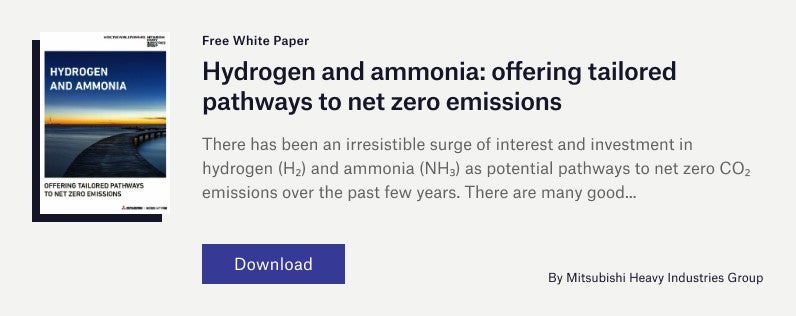
With fossil fuel prices currently at a record high, prices for producing green hydrogen and ammonia fuel, using electricity from renewable energy sources, have become much more competitive. But while this would seem to be the perfect time for investing in such renewables, there are also many geopolitical and environmental insecurities in the supply chain. Renewable electricity prices are increasing, as are costs of raw materials, and many countries are currently looking at energy security more than their carbon footprint right now.
“The most important factor is the contribution of renewables in general, with green hydrogen being a booster for energy independence,” says Professor Kakaras. Presently working for Mitsubishi Heavy Industries (MHI) Group, Duisburg Branch, the professor has also overseen over a hundred scientific research projects as director of the Laboratory of Steam Boilers and Thermal Plants at the National Technical University of Athens, in a career spanning over 30 years.

Discover B2B Marketing That Performs
Combine business intelligence and editorial excellence to reach engaged professionals across 36 leading media platforms.

The professor warns against using the current pricing situation as a ‘snapshot’ for guiding investment. The real gains will be energy independence and long-term decarbonisation, he says, although Kakaras does see opportunities ahead: “The opportunity window is here, to move to large scale projects and gear up towards infrastructure creation. Hydrogen needs sufficient and substantial infrastructure.
“You need a competitive pricing structure on the renewable electricity side to justify reasonable production costs versus the alternative, and you need a reasonable business case on the demand side, that’s mainly due to the carbon pricing and the energy pricing that would justify end users to do the switch. This is the only time in the recent past that we have both available, and that’s why we are calling on speeding up the larger projects, industrial uses, infrastructure, and so on.”
The role of ammonia in the energy transition
“Ammonia will be a key energy carrier in the global effort towards decarbonisation,” says Kakaras. “To facilitate the commoditisation of hydrogen you need to transport this energy. For small distances, this means hydrogen pipelines, but long-distance transport usually means sea transport. This is when things become more complicated because we cannot follow the model of LNG (liquefied natural gas) with hydrogen.”
The compression and re-evaporation costs of hydrogen – which is a very light molecule – requires extremely low temperatures for liquefaction and is therefore much more expensive than LNG. Instead, the energy carrier ammonia is used. Kakaras explains that to transport hydrogen within the ammonia molecule, and then break it down to hydrogen again may sound a bit awkward, but in terms of cost you need to consider scalability.
“Obviously you look to utilise green ammonia directly as much as possible, to avoid the reconversion cost associated with cracking ammonia to produce hydrogen again,” points out Kakaras. “If you ship large quantities of green ammonia, you must look to boost the ammonia use to avoid the reconversion cost wherever possible. So, we are now witnessing a case where ammonia has value, not only as a hydrogen carrier, but as a fuel — as an energy carrier.”
Greening India and the ‘Hydrogen Backbone’ project
In May 2022, President Emmanuel Macron and Prime Minister Narendra Modi gave a clear mandate to foster bilateral cooperation on hydrogen[i] and establish a reliable and sustainable value chain for decarbonised hydrogen. Kakaras has championed such agreements in the past and says that green hydrogen could have a significant effect on India’s energy independence.
The importance of hydrogen in India, which uses mostly coal and imported gas, means that energy is still not affordable for the average Indian person. Kakaras notes: “There are two important factors. First is the decarbonisation of the country, the second is the competitiveness of the local economy. If these two aspects are met, then perhaps we will see, in the future, India as an energy exporter. But this will not happen overnight.
“I’m very happy for this development because I have a strong affinity to the energy supply issues on the Indian continent. This calls for the creation of infrastructure for both supply and demand, and that’s the ‘Hydrogen Backbone.’ Without that, we will not have a hydrogen economy. But we will also need to develop ports. Ports will play an important role for import and export hubs for hydrogen. It’s not by coincidence that all major hydrogen hub projects are around ports.”
The European Hydrogen Backbone (EHB)[ii] initiative is Europe’s dedicated hydrogen transport network, consisting of thirty-one energy infrastructure operators. Spanning 21 countries and tens of thousands of kilometres of pipeline stretching across the continent by 2040, the network will connect the UK, France, Spain, Italy, and North Africa with projects that generate, store and transport hydrogen. The latest addition to the network, a Danish-German hydrogen connection, has been advanced from 2035 to 2030 partly due to an ambitious political agreement[iii] that see ambitions for Denmark as a net exporter of renewable energy, including green hydrogen.
Hydrogen comes in different colours
One aspect of energy security that is seldom addressed is the idea of ‘back-up’ coal power generation for use in times of market uncertainty or national emergencies. Kakaras is of the opinion that such facilities will stay for the foreseeable future: “We are seeing in Germany and Poland a prolongation in the lifetime of coal-fired generation. Given that fact, we can still utilise or substitute part of the coal with green ammonia without significant investment, or any adverse effects on NOx emissions.”
Kakaras sees this as a win in difficult circumstances, what he calls ‘low-hanging fruit.’ “I am always very happy to promote this idea because you need to reduce the carbon footprint of highly emitting assets wherever you can. And there is nothing bad about that. In fact, I would advocate for similar applications in other places of the world.”
Kakaras says that he is neutral on the ‘colour’ of hydrogen: “For me, having this hydrogen infrastructure, having the ammonia terminals, all these things are moving to introduce hydrogen. Sometimes the public is wary that you are trying to keep coal longer, when in fact the truth is that you are trying to improve the business case of the green ammonia and green hydrogen introductions quicker. We need to do more and explain better. Co-utilisation of ammonia with coal assets should be replicated around the world, because this is the low hanging fruit that will pave the way for the quicker introduction of green hydrogen.”
Decarbonisation of Singapore
Hydrogen may come in many colours, but high energy use communications hubs, such as Singapore, are looking to hydrogen gas turbines to ‘green’ their data centre operations. MHI is currently one of three companies involved in the Jurong Island ammonia powered turbines project.
“This will be one of the first to demonstrate a fully decarbonised gas turbine, highlighting the potential of green ammonia, as both a carrier and as fuel,” Kakaras explains. “This will be quite visionary because this may be the ammonia terminal of the future. It’s about infrastructure, the ammonia value chain and carbon-free ports working together.”
Part of Singapore’s National Hydrogen Strategy, low-carbon hydrogen has the potential to be a major decarbonisation pathway to support Singapore’s transition to net zero by 2050. Given Singapore’s limited ability to generate renewable energy domestically, facilities such as Combined Cycle Gas Turbines (CCGTs) may soon be running on a blend of hydrogen and natural gas. Analysis of data supplied by Singapore’s Ministry of Trade and Industry[iv], suggests that CCGTs able to run fully on hydrogen are expected to come online around 2030, with the Ministry predicting hydrogen could meet up to 50% of the country’s projected electricity demand by 2050.
Gen 3 research will help to reach decarbonisation targets
New technology such as improvements to the Haber-Bosch process are currently being researched in the United States[v]. Such ‘Gen 3’ research is vital moving forward to improve efficiency and bring conversion costs down. MHI is investing heavily in R&D to make the ammonia cracking technology more efficient, which Kakaras claims will be a ‘game changer’ in the commoditisation of hydrogen using ammonia as a carrier: “Two examples: Number one, these conventional plants are constant load operation whereas green hydrogen production is fluctuating (being renewable) so you need to do improvements on the synthesis process itself. Number two, the ammonia conversion. Cracking technologies need to be able to release hydrogen again at the point of use.”
Kakaras says he is optimistic the industry will adapt to alternative fuels such as green hydrogen/ammonia quickly enough to reach international goals for decarbonisation set for 2030 and 2040: “I see lots of commitment; I see lots of investment appetite. Globally, the targets to 2040 are the crucial ones – they will require the paradigm shift; the massive rollout of green fuels, of carbon neutral fuels, tackling the hard to abate sectors. These are the things that must be done between 2030-40 and for that we need enabling technology at scale, by the end of the decade, and proven reliability. Then the market will take care of the rest.”
MHI’s expertise
MHI has all the enabling technologies for decarbonisation, points out Kakaras, including hardware and infrastructure in place. MHI recently announced a ‘hydrogen park’ in Takasago Machinery Works in Hyogo Prefecture, Japan[vi] which is set to become a central point of R&D and manufacturing of gas turbines.
“We’re using all the opportunities, the funding from the DOE and demonstrating at scale,” notes Kakaras, “we have the CO2 value chain technology, which is equally important towards carbon neutrality. Capturing, compressing, transporting CO2, even utilising CO2. MHI has announced a corporate commitment towards carbon neutrality by 2040.
“I also think that using ammonia as a fuel for marine purposes is completely sound and transparent, and we are not compromising on safety. We are fully aware of the necessity of having regulations and good practice in place, and MHI have considerable experience in handling ammonia without any safety issues.”
The professor is optimistic about the future of energy and decarbonisation: “I wouldn’t be here doing the job if I were not optimistic. All my professional life, I have been pioneering energy efficiency.”
Mitsubishi Heavy Industries (MHI) Group is one of the world’s leading industrial firms, operating in various sectors including power and energy, and delivering integrated solutions to realise a carbon-neutral world. For more information, download the paper below.
[i] https://www.livemint.com/industry/energy/france-and-india-adopt-joint-roadmap-on-green-hydrogen-11666106317794.html
[ii] https://ehb.eu/
[iii] Hydrogen Market Developments – GlobalData, May 2022
[iv] https://www.ema.gov.sg/media_release.aspx?news_sid=202210246JoalvsFYBOc
[v] https://www.rti.org/news/rti-international-awarded-funding-us-department-energy
[vi] https://www.power-technology.com/sponsored/alternative-fuels-and-the-role-of-carbon-free-hydrogen/


